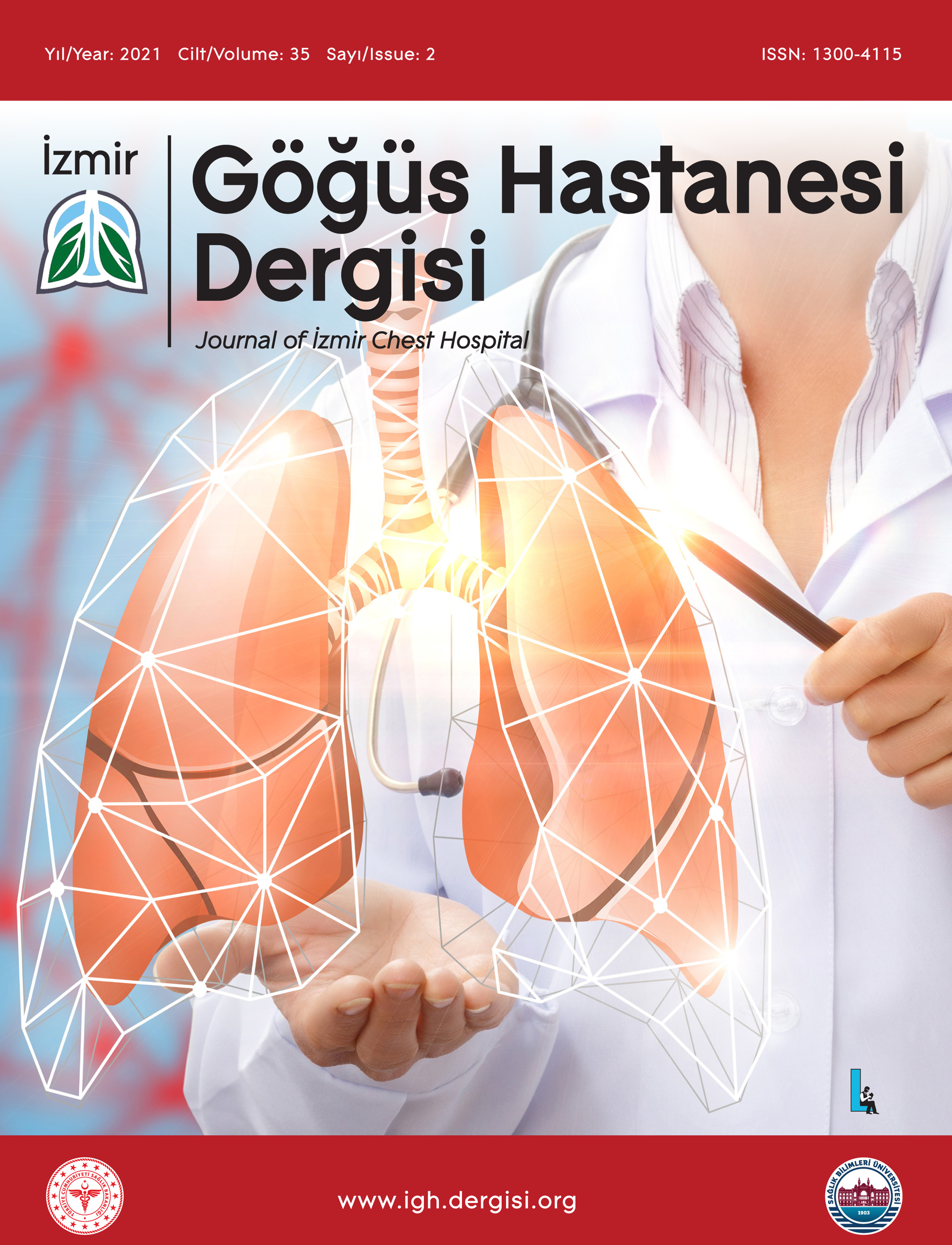HEPATİK HİDROTORAKSA GÖĞÜS CERRAHİ BAKIŞ AÇISI
Tugba COSGUN1, Ali ÖZER2, Hikmet AKTAŞ3, Gül DABAK4, Remzi EMİROĞLU21Acıbadem Üniversitesi Atakent Hastanesi, Göğüs Cerrahisi kliniği, İstanbul, Türkiye2Acıbadem Üniversitesi Tıp Fakültesi, Genel Cerrahi, istanbul, Türkiye
3Acıbadem Üniversitesi Tıp Fakültesi, Genel Cerrahi, Bursa, Türkiye
4Acıbadem Üniversitesi Tıp Fakültesi, Göğüs Hastalıkları, istanbul, Türkiye
Giriş: Hepatik hidrotoraks karaciğer transplantasyonu yapılan merkezlerde sık karşılaşılan, tedavisi medikal ve/veya cerrahi olan klinik bir antite olup, göğüs cerrahisi uzmanlarının konsültasyon istenme gerekçelerindendir. Çalışmamızın amacı karaciğer nakli yapılan hasta grubumuzda preoperatif ve erken postoperatif dönemde görülebilen hepatik hidrotoraks sıklığını saptamak, tedavi sürecimizi gözden geçirmek, tedavi süreci ve sonuçlarını paylaşmaktır. Gereç ve Yöntem: Hastanemiz karaciğer nakil ekibi tarafından Mart 2012-Aralık 2015 tarihleri arasında karaciğer transplantasyonu gerçekleştirren 172 hastanın (97 erkek, 75 kadın; ortalama yaş 52,56±12,1) sonuçları retrospektif olarak değerlenirildi. Hastaların demografik, klinik, radyolojik özellikleri irdelendi. Hastalar efüzyon miktarına göre evrelendi. Durumun yoğun bakım, hastanede yatış süresine ve mortaliteye etkisi incelendi. Bulgular: Preoperatif hidrotoraks olan hastalarda postoperatif hidrotoraks görülme ihtimalinin de yüksek olduğu izlendi (p=0.033). Preoperatif dönemde efüzyon saptanan hastaların %25,5ine, postoperatif dönemde efüzyon saptanan hastaların %29,9una grade 2 olduğu için drenaj uygulandı. Preoperatif veya postoperatif hidrotoraks gelişimi ile hastaların yoğun bakımda yatış süresi, hastanede kalma süresi ve mortalite oranları arasında anlamlı fark bulunmadı. Tartışma: Sadece grade 2 olarak tanımladığımız hasta grubuna drenaj uygulayarak iyi sonuçlara ulaşılabileceğini gösterdiğimiz çalışmada; sonuçlarımızın hepatik hidrotoraks sebebiyle danışılan göğüs cerrahlarına yaklaşım konusunda yardımcı olacağı görüşündeyiz.
Anahtar Kelimeler: Karaciğer nakli, siroz, plevral efüzyon, göğüs cerrahisiPERSPECTIVE OF THORACIC SURGEONS ON HEPATIC HYDROTHORAX
Tugba COSGUN1, Ali ÖZER2, Hikmet AKTAŞ3, Gül DABAK4, Remzi EMİROĞLU21Acıbadem Üniversitesi Atakent Hastanesi, Göğüs Cerrahisi kliniği, İstanbul, Türkiye2Acıbadem Üniversitesi Tıp Fakültesi, Genel Cerrahi, istanbul, Türkiye
3Acıbadem Üniversitesi Tıp Fakültesi, Genel Cerrahi, Bursa, Türkiye
4Acıbadem Üniversitesi Tıp Fakültesi, Göğüs Hastalıkları, istanbul, Türkiye
Introduction: Hepatic hydrothorax treated medically and/or surgically which is frequently encountered in liver transplant centers is one of the indications thoracic surgeons are called for consultations. The aim of our study is to estimate the rate of hepatic hydrothorax in our transplant cases in the pre-posttransplant period, to make an overview of our treatment protocol and to assess the effect of treatment and its results. Material and Methods: Data of 172 hepatic transplant patients(97 male,75 female;mean age: 2.56±12.1) operated between March 2012- December 2015 were retrospectively reviewed. Demographic, clinical and radiologic features were evaluated. Patients were graded according to the volume of effusion. Taking surgical interventions into consideration, the role of the presence of hepatic hydrothorax was evaluated with respect to intensive care, hospital stay, morbidity and mortality. Results: atients who had preoperative hydrothorax tended to have more frequent hydrothorax postoperatively (p=0.03). 25.2% of preoperatively determined hydrothorax patients, and 29.9% of postperative hydrothorax patients underwent thoracic drainage owing to their grade was2. Hepatic hydrothorax didnt affect duration of stay in postoperative intensive care unit and hospital, and mortality. Conclusion: Our study that we reached good results by performing drainage to patients described grade2, may provide a perspective to consultant thoracic surgeons in the management of hepatic hydrothorax.
Keywords: Liver transplantation, cirrhosis, pleural effusion, thoracic surgeryMakale Dili: Türkçe






